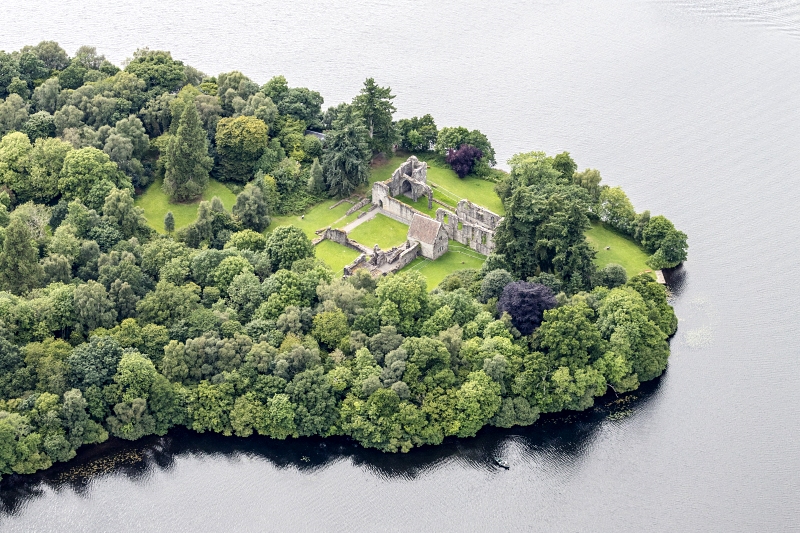
The abbey is just visible through the trees on the island and I close my eyes for a moment, imagining other boats, crude vessels from centuries ago making this same journey.
Founded in 1238 by Walter Comyn, 4th Earl of Menteith, Inchmahome was visited by both Robert I and II. As many other great landowners of the time, Comyn dedicated this land to men of God, not only to have a private place of worship when desired, but also to make restitution of sorts for his warring nature. It's a secluded and idyllic spot and easy to imagine the Augustinian canons going about their day to day lives here.
The boat pulls up to the dock and we disembark. The island is heavily wooded and we are greeted by yet more swarms of midges, which we wave away. We show our passes at the small admission center/gift shop and head out into the ruins.
Much of the priory is fragmentary remains, but the walls of the choir, nave and chapter house rise up among the towering trees. There is such a sense of serenity here, more so than any other priory or abbey we have visited on this trip, perhaps owing to its location. On a warm sunny summer day such as today it's difficult to imagine this place dusted with snow and the lake whipped up into choppy waves. I get a shiver down my spine thinking of the wintry winds that must assail Inchmahome and imagine the canons and their chosen solitary existence out here, remote from civilization on the distant shores.
As we have at all of the ruins we have visited, we leave no nook or cranny unexplored. Heather and mosses that grow out of the walls; inside the chapter house we are rewarded by the effigies of an armed knight and the double effigy of Walter Stewart, Walter Comyn's nephew, and his wife. There is also an impressive grave slab with engraved sword hilt and knotwork cross head.
We wander slowly through the green of the cloister and spy a path that leads off into the woods. The midges are eating Dana alive so she passes up a venture into the woods, where they will certainly be more voracious, and heads back to sun herself on a bench overlooking the lake.
It's cool, dark and silent under the canopy of leaves as Robin and I follow the twisting narrow path through gnarled ancient trees. A large oak on the opposite shore has toppled and rests on its side; its roots look like Celtic knotwork to me. It's so quiet and still here, a silence that is broken by a loud cry of dismay that makes me turn my head quickly looking for the source.
Robin and I learn later from Dana that one of the fisherman had caught a fine fish, only to have it stolen by a gull that swooped down and plucked from the line. With Dana's gift for storytelling I can perfectly picture the man shaking his fist at the sky spewing epithets at the bird.
All too soon it's time to leave Inchmahome behind. We have many miles to cover today on our circle tour and head back to the dock where the ferry is waiting. There are many more boats on the water as we make our way back across the lake, the water is a little rough and I'm keeping a close eye on Robin's face. She doesn't seem to mind it at all though, and explains that it's not the water or the roughness of the water, only the stepping to and from the boat at the dock that bothers her. Soon enough we are safely ashore and back in the car.
Robin takes off her sunglasses and they fall apart in her hand. A tiny screw that holds the earpiece to the frames has worked its way out of its socket and now is somewhere under the drivers seat. We spend a few minutes trying to find it, but really have no time to waste today. As bright as the sky is this day, sunglasses are a necessity, so we agree to keep an eye out (no pun intended) for an optician's shop in whichever towns we travel through.

Inchmahome Priory has a long history of receiving many notable guests. King Robert the Bruce visited three times: in 1306, 1308 and 1310. His visits were likely politically motivated, as the first prior had sworn allegiance to Edward I, the English king. In 1358 the future King Robert II also stayed at the priory.
In 1547 the priory served as a refuge for Queen Mary, aged four, hidden here for a few weeks following the disastrous defeat of the Scots army at the Battle of Pinkie Cleugh during the Rough Wooing.
The decline of the monastic orders in the 16th century was hastened by the fact that the heads of abbeys and priories became appointees of the local landowner, who often did not share the religious goals of the monks or ordained priests. In 1547, the office passed to John, Lord Erskine, who later became head of Cambuskenneth and Dryburgh abbeys.
The Scottish Reformation meant that there were no new priests being ordained, and religious land and buildings gradually passed into secular hands, leading to the priory's inevitable decline.
In 1606 the land and property passed to the Erskine family, and later to the Marquess of Montrose; the 6th Duke of Montrose passed it into the care of the State in 1926.
Read more about Inchmahome Priory at Wikipedia.